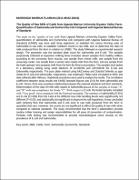| dc.description.abstract | MURONGO MARIUS FLARIAN (2011-M152-20016)
The Quality of Raw Milk of Cattle from Uganda Martyrs University Equator Valley Farm: Quantification of Salmonella and Escherichia Coli Compared with Uganda National Bureau of Standards
The study on the “quality of raw milk from Uganda Martyrs University Equator Valley Farm: quantification of salmonella and Escherichia coli compared with Uganda National Bureau of Standards (UNBS) was done with three objectives; to establish the colony forming units of Salmonella in raw milk; to establish Coliform counts in raw milk, and; to determine the class of milk produced from the farm in relation to UNBS. The study followed an experimental research design. The parameter was the standard plate count for salmonella and E.coli. The samples purposively collected at respective milking times included; eleven samples from healthy milkers according to the university farm records, one sample from mixed milk, one sample from the university cooler, one sample from a vendor who retails milk from the farm, and one sample from the hotel operator who prepares milk from the farm for final consumption. The samples were tested in a laboratory setting using serial dilutions of 10.000mls and 100.000mls for E.coli and Salmonella respectively. The pour plate method using McConkey and Dulcitol Selenite as agar media for E.coli and Salmonella, respectively, was employed. Plates were incubated at 350C and data collected after 48hours. Statistical procedures were used to analyse the results. The correlation coefficient between study results and UNBS standard figures was (0.9) for both salmonella and E.coli. Hence, there was a positive relationship between the national standards and farm standards. Determination of the class of milk with respect to Salmonella placed all the samples in Grade “A” and “B” with non-compliance for Grade “C”. With respect to E.coli, the tested samples complied with “Very good” class compared with the National standards. The numbers of salmonella (0.301) and E.coli (0.1206) from the t-test at the different raw milk handling levels were significantly not different (P=0.05), and statistically not significant to disprove the null hypothesis. It was concluded with certainty then that Salmonella and E.coli exist in raw milk produced from the farm in quantities that vary. However, the counts are not significant to affect the quality of raw milk when compared to national standards. The study recommended that the farm’s stakeholders provide routine milker training and assign responsibilities for all areas of prevention of contamination. Periodic milk testing was recommended to provide microbiological count records on the prevalence of E.coli and Salmonella.
Key words: Milk, Cattle, Farm, Salmonella, Escherichia, Standards | en_US |


